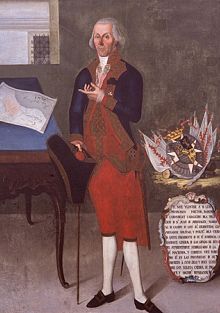Francisco Luis Héctor de Carondelet
|
Barón Francisco Luis Hector de Carondelet |
|
|---|---|

Francisco Luis Hector de Carondelet
|
|
| Born | 1748 Noyelles-sur-Selle, Flanders |
| Died | 1807 Quito, Ecuador |
| Resting place | Cathedral of Quito |
| Occupation | Spanish military officer; Governor of Louisiana and West Florida, Governor of El Salvador, President of the Royal Audiencia of Quito |
| Spouse(s) | Maria Concepción Castaños y Aragorri |
| Parent(s) | Jean Louis de Carondelet and Marie Angélique Bernarde de Rasoir |
| Awards | Order of Malta |
Francisco Luis Hector, barón de Carondelet (born 1748, Noyelles-sur-Selle, Flanders – died 1807 Quito, Ecuador) was an administrator of Burgundian descent in the employ of the Spanish Empire. He was a Knight of Malta.
Carondelet entered the service of the King of Spain in 1762, at age fifteen. By 1783, he commanded the IV Division, which fought at the Siege of Pensacola in 1783. Upon his return to Spain in 1787, he was attached to the Plandes Regimiento, with the rank of Infantry Colonel, and received the Order of Malta. During this period, he married a woman from Aragón whose family was very influential at the royal court, Maria Concepción Castaños y Aragorri.
Carondelet was named governor of El Salvador in 1789. Because the local indigenous population working in the indigo industry had declined greatly, Carondolet recruited Spanish laborers. Their descendants are among the blonde and fair-skinned people of today's Chalatenango Department.
After his term as governor of El Salvador ended he was appointed governor of the Spanish colonies of Louisiana and West Florida, from 1791 to 1797. Fluent in French, he was well regarded by the French Creole population. He established Louisiana's first newspaper, Le Moniteur. He made many improvements in the infrastructure of New Orleans, including the Carondelet Canal and the city's first street lighting. The street light tenders (attendants) served as watchmen and de facto municipal police.
...
Wikipedia
